The Parable of the Picture
Part of an ongoing, perhaps never ending, conversation:
I believe the heart of his argument is that if everything is not ultimately ‘mechanical’ then the non-mechanical (be it spiritual or mental) must at some point interface with the mechanical world and therefore alter the course of the mechanical world. Whereby purely Newtonian mechanics would have led said atom/electron/whateveron to go ‘left’ all of a sudden it goes ‘right’ instead because of the interface of the mechanical and non-mechanical. This would seem to add energy (among other things) into the mechanical universe and therefore violate our current understanding of physics.
If you (Mr Wright) could explain your understanding of this interface then it might solve the challenge in understanding.
My understanding is that there is no interface.
Imagine physics describing the tiny dots of silver nitrate or the pixels of which a picture of a snowy mountain in the moonlight is composed.
Those properties can be measured precisely, and expressed as numbers (magnitudes). Any rational and honest beings will agree on these properties by referring to the empirical evidence. Unless the measurements were done in error, there is no room for debate. No judgment and no taste is required to settle any conflict of opinion about the picture.
Imagine also that the picture has other properties which cannot be described in terms of the position or size or darkness of dots, imponderable but real properties such as elegance of composition, nice use of perspective, flattering lighting, the sublime beauty of the subject, and so on. Those properties are real and cannot be measured. Differences of opinion cannot be solved by reference merely to empirical data: the opinions rest on a judgment call, which in tern rest on a proper sense of taste and proportion, and a proper knowledge of aesthetics. Because these things are not open to empirical measurement, the crude superstition that replaces thinking in the modern age reacts dismissively, akin to loathing, to the suggestion that reason has a role in making judgments. (The modern age, for example, would never be able to invent the institution of a jury trial, because moderns do not believe that rational and objective judgment is possible in any area other than physics; and ergo all judgments are ally equally arbitrary and meaningless — piffle and prattle and hellish nonsense, of course.) Whatever one’s opinion about the crude superstitions of the modern age, it is at least clear that there is a difference between deducing measurable properties and judging imponderable properties.
Now, if I were to ask you what is the “interface” between the pixels and the picture, would that question even make sense to you?
On the one hand (1) Clearly we can change one to change the other; if you paint over a picture or photoshop a photograph, you will change the elements in it, both the measurable and the imponderable.
On the other hand (2) equally clearly there is something in the mix that is greater than the sum of it parts. The beauty of a picture of a majestic mountain beneath the moon, with plumes of snow flying from the horns of the mountain crown like banners from a dark knight’s helm is not something that a mere list of numbers giving you the x and y coordinates of the pixels will tell you. A human observer whose tastes are trained to see beauty properly has to see the picture with his eye to judge whether the alternations of white snow and black crag are sublime.
Likewise, a human observer who sees both the picture of the mountain and the real mountain is needed to judge whether the image is accurate as opposed to misleading. And even unretouched photographs can be misleading, if the cameraman deliberately, for example, uses a trick of perspective he knows is likely to fool an unsuspicious eye. “Misleading-ness” is not a property that can be deduced from a row of numbers defining pixel positions (unless, of course, you organize the numbers to form an image of the picture, and have human observer look at it to make a judgment of the picture’s accuracy, in which case we are right back where we started.)
Two scientists who meet to settle a dispute over some physical property of the picture (let us say, they wish to examine the age of the ink to detect whether it might be a forgery) will not, in their role as scientists, discuss the merit of the composition or the use of chiaroscuro to achieve a dramatic illusion of depth. Likewise, two art jurors who meet to settle a dispute over some artistic property of the picture (let us say, they wish to examine the personality of the composition to detect whether it might be a forgery) will not, in their role as jurors, discuss the technicalities of carbon 14 dating of the ink molecules. The two languages are incompatible and incommensurate, even though the art-scientist and the art-juror are talking about the same object and the same topic.
Now, the human mind is something like the composition of the picture in this analogy. Let us imagine a picture where, perhaps due to ultimately simple rules governing cellular automata, the picture elements are in motion. The human brain is something like the mechanics of the animated pixels. The analogy of a human mind to a moving picture fails, however, because no picture can, based on the meaning of the images in the picture, direct itself toward another meaning of another type: cellular automata like the one shown below are passive, driven by their inflexible rules.
The soul can be vicious or virtuous, true or false, and so on. The motions of the brain atoms are like the pixels.
Clearly some things arise from the mind which change the brain and the body: when I snap my fingers, that is a deliberate act. I can raise my heartbeat with angry or lustful thoughts, or blush, or create other physical changes. The mind affects the body.
Likewise again, drugs or fatigue or a blow to the head can disorganized my thought process, or induce hallucinations, even to such a point of incapacity that I might no longer be legally responsible for my actions: such a drug can turn me from a manlike creature to a beastlike creature.
There human wisdom ends. The exact relation, or even whether there is or is not an exact relation, between the compositional brain atoms and the imponderable reality of the mind is not just elusive, it is, in my opinion, insoluble. I do not believe human beings can think of physical objects except in categories of cause and effect; and I do not not believe human beings can think of mental acts except in categories of right and wrong, means and ends; but the one underlying reality of which the brain is the matter and the mind is the form cannot be distinguished into one of those categories or the other without ignoring half of the question.



